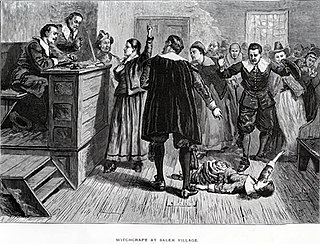Abigail Williams was one of the initial accusers in the Salem witch trials, which led to the arrest and imprisonment of more than 150 innocent people suspected of witchcraft.
Elizabeth Parris was one of the young women who accused other people of being witches during the Salem witch trials. The accusations made by Betty (Elizabeth) and her cousin Abigail caused the direct death of 20 Salem residents: 19 were hanged and one man was pressed to death.
Elizabeth Proctor was convicted of witchcraft in the Salem Witch Trials of 1692. She was the wife of John Proctor, who was also convicted, and he was executed.

Tituba was an enslaved woman, owned by Samuel Parris of Danvers, Massachusetts. Although her origins are debated, research has suggested that she was a South American native and sailed from Barbados to New England with Samuel Parris. Tituba was the first to be accused of practicing witchcraft during the 1692 Salem witch trials. Little is known regarding Tituba's life prior to her enslavement. However, she became a pivotal figure in the witch trials when she confessed to witchcraft while also making claims that both Sarah Good and Sarah Osborne participated in said witchcraft. She was imprisoned and later released by Samuel Conklin, but little to nothing is known about Tituba's life following her subsequent release.

Bridget Bishop was the first person executed for witchcraft during the Salem witch trials in 1692. Altogether, about 200 people were tried, and 20 others were executed.

Sarah Good was one of the first three women to be accused of witchcraft in the Salem witch trials, which occurred in 1692 in colonial Massachusetts.

Eunice Cole, maiden name unknown, was a woman from the coast of New Hampshire. Better known as "Goody Cole", she is the only woman convicted of witchcraft in New Hampshire.

Martha Corey was accused and convicted of witchcraft during the Salem witch trials, on September 9, 1692, and was hanged on September 22, 1692. Her second husband, Giles Corey, was also accused.
Ann Foster was an Andover widow accused of witchcraft during the Salem witch trials.
Sarah Osborne was one of the first women to be accused of witchcraft in the Salem witch trials of 1692.

Rebecca Towne Nurse was executed for witchcraft by the government of the Province of Massachusetts Bay in New England during the Salem Witch Trials in 1692. She was the wife of Francis Nurse, with several children and grandchildren, and a well-respected member of the community. Because there was spectral evidence against her, she was convicted and hanged as a witch on July 19, 1692. This occurred during a time when the Massachusetts colony was seized with hysteria over witchcraft and the supposed presence of Satan within the colony. Her married sisters Mary Eastey and Sarah Cloyce were also accused of witchcraft. Mary was found guilty and executed, but Sarah survived.

Ann Pudeator was a well-to-do septuagenarian widow who was accused of and convicted of witchcraft in the Salem witch trials in colonial Massachusetts. She was executed by hanging.
Dorcas Hoar was a widow accused of witchcraft during the Salem witch trials of 1692, found guilty and condemned to hang, but then confessed and with the support of several ministers, was given a temporary reprieve after which the trials had already ended.
John Putnam Demos is an American author and historian. He has written two books that discuss witch hunts and has discovered that one of his ancestors was John Putnam Senior, a member of the Putnam family that was prominent in the Salem witch trials.
Elizabeth Howe was one of the accused in the Salem witch trials. She was found guilty and executed on July 19, 1692.
Abigail Faulkner, sometimes called Abigail Faulkner Sr., was an American woman accused of witchcraft during the Salem witch trials in 1692. In the frenzy that followed, Faulkner's sister Elizabeth Johnson, her sister-in-law Deliverance Dane, two of her daughters, two of her nieces, and a nephew, would all be accused of witchcraft and arrested. Faulkner was convicted and sentenced to death, but her execution was delayed due to pregnancy. Before she gave birth, Faulkner was pardoned by the governor and released from prison.
Isaac Eastey was the husband of Mary Eastey, who was executed during the Salem Witch Trials of 1692. Isaac and Mary were both highly respected members of the Salem Village Church, and the community in general. Isaac played a significant role in the witch trials, which is often overlooked in history. Despite being one of the primary reasons for Mary's accusation, he desperately tried to clear his wife's name and put an end to the trials altogether.
Mary Black was a slave of African descent in the household of Nathaniel Putnam of the Putnam family who was accused of witchcraft during the Salem witch trials. Nathaniel's nephew was Thomas Putnam, one of the primary accusers, though Nathaniel himself was skeptical and even defended Rebecca Nurse. Mary was arrested, indicted, and imprisoned, but did not go to trial, and was released by proclamation on January 21, 1693 [O.S. January 11, 1692]. She returned to Nathaniel's household after she was released, another indication of Nathaniel's view of the charges against her.

Martha Carrier was a Puritan accused and convicted of being a witch during the 1692 Salem witch trials.













